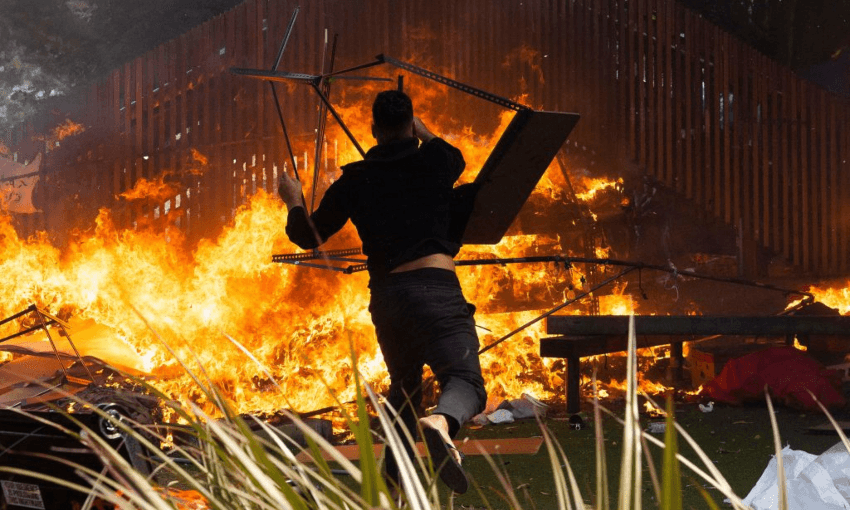Summer read: The second of March is now inked forever in New Zealand’s history. Toby Manhire examines the forces which brought us here, and asks what comes next.
First published March 3, 2022
The end was ugly. A reel of scenes that seemed to come from some faraway place, beamed against the backdrop of our parliament. Hundreds of riot police, many clad in body armour. Pepper spray. Sonic cannons. Fire hoses. The rioters hurled bricks, fire extinguishers, anything they could lay their hands on, all raining down on plastic shields. Fires were lit across the ruined grounds, tents turned into pyres, the mob feeding the flames with cardboard, plywood, gas bottles – indifferent to anyone who might be nearby. The children’s playground was targeted by arsonists. Someone tried to burn down the Old Government Buildings.
One of the ugliest days in our history, but it could have been uglier. By the end of March 2, 2022, the grounds of parliament were clear, if barely recognisable. Police – whose restraint throughout was commendable – had not expected to achieve so much by dusk. No one had stormed the houses of parliament. No one had lost their life.
Hindsight suggests that Commissioner Andrew Coster erred by failing to adopt the hard-and-early mantra in dealing with the illegal encampment. Equally, the outbursts of violence in response to the effort yesterday vindicated his assessment that attempting to shut down the occupation when it was two or three times bigger would have created unacceptable risk to all.
In this episode of Gone By Lunchtime, Annabelle Lee-Mather, Justin Giovannetti and Toby Manhire assess the crackdown at parliament, the political response to the occupation, and the omicron surge.
Across more than three weeks, the occupation of parliament grounds in Wellington flexed itself wildly out of proportion to the numbers taking part. The Pipitea crowd, even at its peak, was a speck compared to the many thousands every day quietly heading out to get their booster shot, to protect themselves, the health system and the wider community against the worst ravages of omicron. This was no expression of a New Zealand divided down the middle. But however unpredictable the saga’s component parts might have been – from Barry Manilow to rubber bullets to the desperately sad scenes of people buying into the very obvious bullshit that their Covid-19 infection was really an illness brought on by electro-magnetic weaponry – the momentum on which it built was not.
As was obvious from the demonstration at parliament in November last year, this was the product of misinformation, fear and conspiracy, the importation of ideas, languages and memes from abroad. All much too serious and ingrained to shrug off with a savvy old no-big-deal. Just as human waste was pumped beneath the occupied streets, a malign and violence-hungry undercurrent ran beneath the parliamentary campsite. The slogan for the 22-day occupation was something like this: Peace, Love, and, you know, Execution by Hanging of politicians, academics, journalists and police.
That is not to say that the majority of people who gathered at the occupation were violent. Most were upset, broken, distressed, isolated, disaffected, bereft. Part of our challenge is to welcome those people home with compassion. But as anyone who cared to lift the slightest stone at parliament grounds or its social media substrata could see, the induction from anti-mandate and anti-vaccine to let’s-put-them-on-trial-for-genocide was terrifyingly efficient. Somewhere in between were the “natural healing” grifters who claim the psychic power to cure cancer and the nurse who told the crowd her lamb’s blood had turned thick and black because it was touched by the spouse of someone who had been vaccinated.
Like many people who grew up, worked in and love the city of Wellington, I feel a real sadness that the grounds of parliament, when they reopen, are bound to be different: less friendly, less accessible, less easy to wander into by accident. But that’s only one of the realities from overseas that is landing with a thud at our feet.
On the ground floor of the Beehive late afternoon yesterday, with the sounds of an ongoing riot echoing metres away, Jacinda Ardern addressed the press and the public. As she had after the mosque attacks in 2019, as she had after the arrival of Covid-19 a year later, the prime minister attempted to distill the crisis facing Aotearoa.
“One day, it will be our job to try and understand how a group of people could succumb to such wild and dangerous mis- and disinformation,” she said. “And while many of us have seen that disinformation, and dismissed it as conspiracy theory, a small portion of our society have not only believed it, they have acted on it in an extreme and violent way.”
She was right to say no New Zealander should allow our Covid response to be defined by the last three weeks. But nor should we dismiss what has happened as some ephemeral freak show. After the appalling, racist mass murder of March 15, 2019, the Christchurch Call was initiated, and steps taken in good faith to curb the spread of extremism online. Today that process looks altogether too friendly. Offshore tech giants, alongside newer but fast-growing fringe channels, continue to be extraordinarily efficient means of disseminating conspiracy theories and disinformation, while amassing outlandish and largely tax-free profits. As Te Pūnaha Matatini’s Sanjana Hattotuwa has shown, the last month has seen social media powered misinformation frequently blast past the reality-based media’s reach on Facebook.
Yesterday at parliament, we were served a gut-wrenching illustration of what happens when you let the mind-virus rip. In a few days we will mark the three-year anniversary of something much worse, something which showed how online extremism and radicalisation does not need an army to wreak unspeakable terror.
Probably I was wrong to say at the outset that yesterday was the end. The most dangerous ringleaders are emboldened, even if most of them had slipped out of sight as the people they had provoked to violence chucked makeshift missiles at police. These people could not give less of a shit about mandates or face masks; they’re more interested in declaring Covid a hoax, claiming trafficked children are locked by paedophile politicians beneath the Beehive and plotting an overthrow of the entire system of government, with “Nuremberg 2.0” trials and a field of executions. And they’re watching their mailing lists and Facebook groups grow.
You’d think that the “sensible” and “moderate” groups who declared themselves leaders of the “anti-mandate” protest would disavow those positions, distance themselves from the extremists in their midst. What could be easier? You’d think that the anti-vax group Voices for Freedom, for example, would shun such people, especially given their claim in a bizarre puff piece the other day that they represent the majority of people at the protest. Surely? Nope. Despite numerous invitations to do so, not a peep.
One of those extremists, Kelvyn Alp, a would-be cult leader who commands an audience in the tens of thousands, lamented yesterday that the second of March, 2022, would have been different had his “boys” been able to pull AK-47s from their car boots. They couldn’t because they had been “disarmed … under a false flag”, he said, in a reference to the gun law reforms that followed the terrorist atrocity of 2019. Alp and his friends are not done. As one person who watches this stuff closely told me yesterday, “now they have megaphones.”


